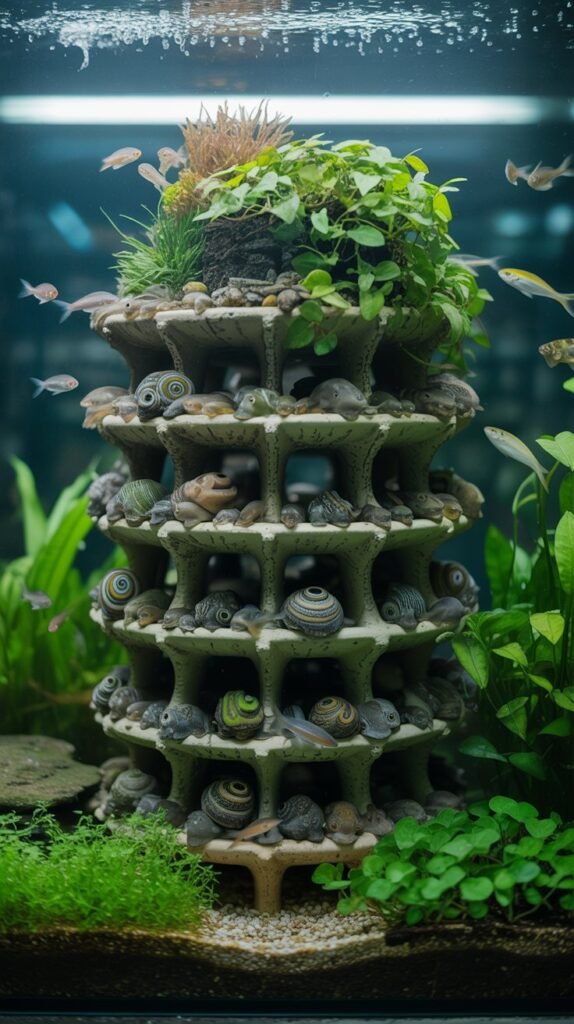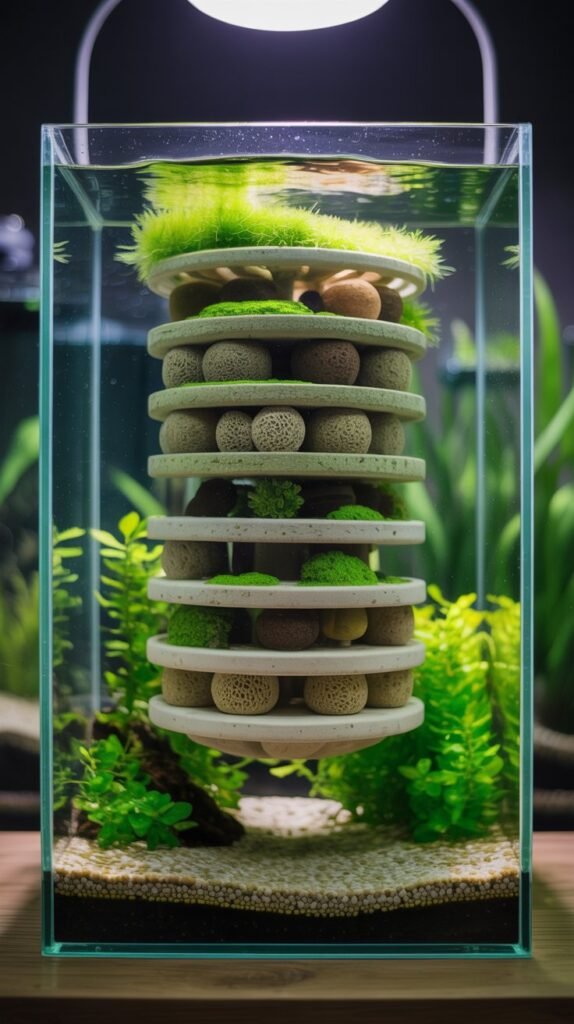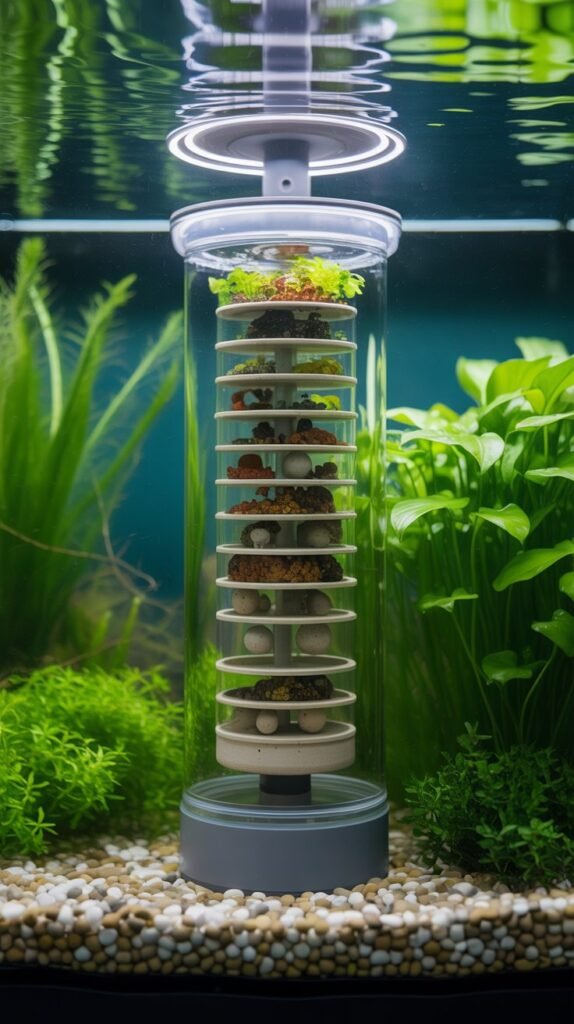Aquariums are miniature ecosystems where fish, plants, and microorganisms coexist. Maintaining balance in this closed environment is crucial for the survival and well-being of aquatic life. One of the most essential components of this balance is the aquarium biofilter. Often referred to as the “biological heart” of an aquarium, the biofilter is responsible for processing toxic waste, ensuring that fish and plants thrive in a clean and stable environment.
In this detailed guide, we’ll explore everything you need to know about aquarium biofilters, including how they work, types of biofilters, their importance, maintenance, and tips for choosing the best biofilter for your aquarium.
What is an Aquarium Biofilter?
An aquarium biofilter is a filtration system designed to promote the growth of beneficial bacteria that break down harmful waste products produced by fish, plants, and uneaten food. Unlike mechanical filters (which remove debris) or chemical filters (which use activated carbon or resins), biofilters rely on biological processes to maintain water quality.

The primary function of the biofilter is to support the nitrogen cycle—a natural process where harmful compounds like ammonia are converted into less toxic substances such as nitrite and eventually nitrate. Without this essential cycle, aquariums would quickly become uninhabitable for fish.
How Does an Aquarium Biofilter Work?
To understand the importance of a biofilter, it’s vital to grasp how the nitrogen cycle works inside an aquarium.
- Ammonia Production
Fish produce waste in the form of ammonia (NH3), and uneaten food or decaying plants also contribute to ammonia levels. Ammonia is highly toxic to fish, even in small concentrations. - Nitrosomonas Bacteria (Ammonia-Oxidizing Bacteria)
Beneficial bacteria colonizing the biofilter media convert ammonia into nitrite (NO2-), which is still toxic but less harmful than ammonia. - Nitrobacter Bacteria (Nitrite-Oxidizing Bacteria)
A second type of beneficial bacteria then converts nitrite into nitrate (NO3-), a much less toxic compound. - Nitrate Management
While nitrates are relatively safe in small amounts, they can accumulate over time. High nitrate levels can harm fish and encourage algae growth, so regular water changes and live plants help manage nitrate buildup.
The biofilter provides the surface area needed for these bacteria to thrive. The more porous the filter media, the more room for bacteria colonies, which improves the efficiency of the biofilter.
Why is an Aquarium Biofilter Important?
The biofilter is critical for several reasons:
- Protects Fish Health: By breaking down harmful ammonia and nitrite, biofilters keep fish safe from toxic water conditions.
- Stabilizes Water Chemistry: They help maintain consistent and stable water parameters.
- Prevents Algae Overgrowth: By controlling excess nutrients, biofilters minimize algae problems.
- Supports Long-Term Aquarium Balance: Without a biofilter, an aquarium would quickly become unlivable for aquatic life.
In short, an aquarium biofilter is not optional—it’s a necessity for maintaining a thriving aquatic ecosystem.
Types of Aquarium Biofilters

There are several types of biofilters, each with unique benefits. Choosing the right one depends on your aquarium size, setup, and maintenance preference.
1. Sponge Filters
- Common in breeding tanks and small aquariums.
- Provide gentle filtration ideal for fry and shrimp.
- Operated by an air pump that pulls water through a sponge where bacteria grow.
2. Hang-On-Back (HOB) Filters
- Popular in beginner setups.
- Hang on the back of the aquarium and combine mechanical, chemical, and biological filtration.
- Easy to maintain and replace media.
3. Canister Filters
- Suitable for large aquariums.
- External units that provide superior biological filtration due to large media capacity.
- Highly customizable with different filter media.
4. Internal Filters
- Submersible filters that sit inside the tank.
- Compact and easy to use, but less efficient than canisters.
5. Undergravel Filters
- Use the gravel bed as the filtration medium.
- Air pumps or powerheads draw water through the gravel, where bacteria colonize.
- Affordable but less effective compared to modern filters.
6. Wet/Dry Filters (Trickle Filters)
- Often used in saltwater or large freshwater setups.
- Expose water to air as it trickles over bio-media, maximizing oxygen for bacterial activity.
Each type has its strengths, but all serve the same purpose: providing surface area for beneficial bacteria to thrive.
Choosing the Best Aquarium Biofilter
When selecting a biofilter, consider the following factors:
- Tank Size: Larger aquariums require filters with greater capacity.
- Stocking Level: More fish produce more waste, so stronger biological filtration is needed.
- Aquarium Type: Breeding tanks, shrimp tanks, or planted aquariums may benefit from gentler filtration.
- Budget and Maintenance: Some filters require more upkeep than others.
For beginners, sponge filters or HOB filters are excellent choices, while experienced aquarists with large tanks often prefer canister filters.
Setting Up and Cycling an Aquarium Biofilter

A biofilter doesn’t work instantly—it needs time to establish beneficial bacteria colonies. This process is called cycling.
Steps to Cycle a Biofilter:
- Install the Filter with appropriate media.
- Introduce Ammonia Source (fish food, pure ammonia, or hardy fish).
- Test Water Parameters regularly for ammonia, nitrite, and nitrate.
- Wait 4–6 Weeks for the nitrogen cycle to complete.
- Add Fish Gradually once ammonia and nitrite drop to zero and nitrates are manageable.
Patience is key—rushing the cycling process can endanger fish.
Maintaining an Aquarium Biofilter
To keep your biofilter effective, follow these maintenance tips:
- Avoid Over-Cleaning: Rinsing filter media in tap water can kill beneficial bacteria. Instead, rinse gently in aquarium water.
- Don’t Replace All Media at Once: If media must be changed, replace only part of it to preserve bacterial colonies.
- Check Water Flow: Ensure the filter is running smoothly and not clogged.
- Regular Testing: Monitor ammonia, nitrite, and nitrate levels to confirm the biofilter is working properly.
Remember, the biofilter is alive—it needs proper care to sustain the bacterial colonies that protect your fish.
Common Mistakes with Aquarium Biofilters
Many beginners make errors that reduce biofilter efficiency. Some common mistakes include:
- Overfeeding Fish → Causes excess waste and clogs filters.
- Cleaning with Tap Water → Chlorine kills beneficial bacteria.
- Skipping Cycling → Leads to “new tank syndrome” and fish deaths.
- Adding Too Many Fish at Once → Overloads the biofilter.
- Neglecting Maintenance → Dirty filters can’t function properly.
Avoiding these mistakes ensures your biofilter continues working at peak performance.
Advanced Tips for Biofilter Optimization
- Use High-Surface Area Media: Ceramic rings, bio-balls, and porous sponges maximize bacterial colonization.
- Maintain Good Oxygen Levels: Beneficial bacteria require oxygen, so ensure proper aeration.
- Add Live Plants: Plants assist by absorbing nitrates and improving overall water quality.
- Consider Multiple Filters: In heavily stocked tanks, using two biofilters increases stability.
Conclusion
An aquarium biofilter is the backbone of a healthy aquarium. By supporting the nitrogen cycle, it protects fish from toxic waste, maintains water quality, and creates a balanced ecosystem. Whether you’re a beginner with a small tank or an experienced aquarist managing a large setup, investing in the right biofilter and maintaining it properly is essential for long-term success.
By understanding how biofilters work, choosing the right type, and avoiding common mistakes, you’ll ensure your aquatic pets live in a clean, stable, and thriving environment.
FAQs About Aquarium Biofilters
Q1. What is the purpose of an aquarium biofilter?
The main purpose is to support beneficial bacteria that convert toxic ammonia into safer nitrates through the nitrogen cycle.
Q2. How long does it take to cycle a biofilter?
Typically, 4–6 weeks are needed for bacteria colonies to establish in a new biofilter.
Q3. Can I clean my biofilter with tap water?
No, tap water contains chlorine which kills beneficial bacteria. Always rinse media in aquarium water.
Q4. Do all aquariums need a biofilter?
Yes, unless the aquarium is heavily planted or very lightly stocked, most aquariums require a biofilter to process waste.
Q5. How often should I replace biofilter media?
Replace only when necessary, and never all at once. Many types of biofilter media can last years if maintained properly.
Q6. Can live plants replace a biofilter?
Plants help absorb nitrates but cannot fully replace a biofilter’s role in converting ammonia and nitrite.
Q7. Why does my biofilter smell bad?
A foul smell may indicate trapped debris, poor maintenance, or anaerobic bacteria. Clean the filter gently with tank water.
Q8. What happens if the biofilter stops working?
If the filter shuts down for too long, bacteria may die off, leading to ammonia spikes and potential fish loss.

